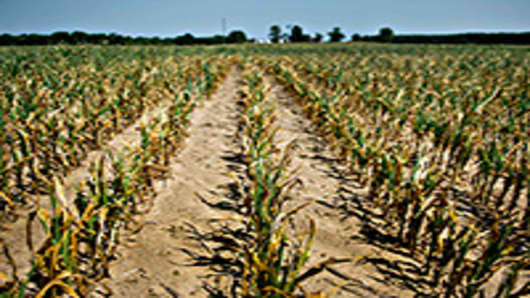The U.S. government declared more than 1,000 counties in 26 states drought disasters, as the economic impact of the worst crop conditions in 24 years begins to be felt.
The U.S. Department of Agriculture announced Wednesday that farmers in those states can qualify for low-interest emergency loans as of Thursday. The USDA said it streamlined its disaster designation process, and the counties are designated as being in severe drought because of eight-consecutive weeks of drought during the growing season.
Earlier, the USDA released its crop report, showing sharply reduced expectations for this year’s harvest and a 12 percent decline in the expected corn crop yield.
The USDA had projected this year’s crop would be a bumper harvest, yielding 166 bushels per acre. It pared that expectation back to 146 bushels, the lowest in nine years. It now expects a total crop of 12.97 billion bushels, the third-largest on record but down from what would have been an all-time high of 14.8 billion bushels.
Grain prices jumpedon the initial 8:30 a.m. EDT crop report, but sold off as rumors swirled ahead of the USDA announcement on drought disaster. Traders said there was a rumor the USDA had an announcement coming that would be a negative for grain prices. Futures prices stayed close to their lows after the announcement.
While the agency reduced its forecast for crop yields, it also cut its demand forecast. “We were blown away that the USDA actually recognized a yield number very realistically. That was a big issue here,” said Rich Nelson, director of research at Allendale.
“For soybeans, we were also surprised the USDA lowered soybean yield and they tempered the bullishness of the number by offsetting the entire supply drop with a drop in demand,” he said. Soybean yields were cut about 8 percent to 40.5 bushels per acre, the second-lowest since 2003.
The hardest-hit areas have been across the southern and eastern areas of the corn belt. “We haven’t had a drought like this since 1988. We’ve had regional droughts but nothing that goes from the Rockies to the Appalachians,” said Shawn McCambridge of Jefferies Bache.
McCambridge said he was surprised the USDA cut its forecast so sharply because it hasn’t yet done on-the-ground surveys.
“They must feel there’s some pretty significant damage in terms of yield losses," he said. "When they go into the field for the August report, we could see another significant reduction."
Follow Patti Domm on Twitter: @pattidomm
Questions? Comments? Email us at marketinsider@cnbc.com




